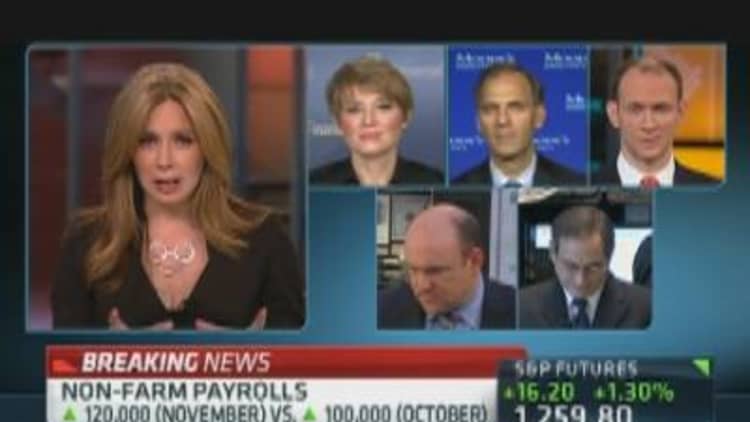Job creation remained weak in the U.S. during November, with just 120,000 new positions created, though the unemployment rate slid to 8.6 percent, a government report showed Friday.
The rate fell from the previous month's 9.0 percent, a move which in part reflected a drop in those looking for jobs. The participation rate dropped to 64 percent, from 64.2 percent in October, representing 315,000 fewer job-seekers.
The actual employment level increased by 278,000. The total amount of those without a job fell to 13.3 million.
The drop in participation rate is significant in that had the labor force remained steady, the jobless rate would have dropped to 8.8 percent, according to Citigroup calculations. If the labor force had followed trend growth, unemployment would be at 8.9 percent.
"Overall, the continued modest employment gains reflect an economy that plods along at an uninspiring pace," Kathy Bostjancic, director of macroeconomic analysis at The Conference Board, said in a statement. "These modest job gains are still not enough to propel economic growth to a sustainable 2 percent-plus growth path."
The measure some refer to as the "real" unemployment rate, which counts discouraged workers, also took a fall to 15.6 percent from 16.2 percent, its lowest level since March 2009.

However, economists were treating the rate drops with skepticism.
"When the unemployment rate declines, we want to see both employment and participation increase as discouraged workers return to the labor force. Today, we got the former, but not the latter, making the 0.4 percent drop look a bit suspect," Neil Dutta, US economist at Bank of America Merrill Lynch, told clients. "We would not be surprised to see the unemployment rate give back some of its decline in the coming month(s)."
Average earnings were essentially flat, up two cents to $23.18 an hour. Private payrolls increased 140,000, considerably less than a report earlier this week showing that nongovernment jobs were up by more than 200,000 for the month.
Government payrolls fell 20,000, including a 4,000 drop in federal positions.
Long-term unemployment remains a big problem: The average duration for joblessness surged to a record-high 40.9 weeks. Stagnation in wages also continues, as more employed workers took on second jobs. There were just under seven million multiple job-holders for the month, the highest total in 2011 and the most since May 2010.
Traders offered little reaction to the report. Futures already had been indicating a positive open but lost some ground in the ensuing minutes after the Labor Department report hit the tape.
"At this pace of job growth, it will be more than two decades before we get back down to the pre-recession unemployment rate. Moreover, a shrinking labor force is not the way we want to see unemployment drop," said Heidi Shierholz, economist at the Economic Policy Institute. "At this rate of growth we are looking at a long, long schlep before our sick labor market recovers."
As expected, the service sector was responsible for the bulk of job creation, adding 126,000 jobs against just 2,000 for manufacturing.
Retail positions rose by 50,000, with 27,00 of that in clothing and clothing accessories stores. Leisure and hospitality added 22,000, with food service and bars up 33,000 to offset a loss of 12,000 in the accommodations industry.
Professional and business services grew 33,000 for the month.
Revisions to previous months' reports also were positive. September was revised up to 210,000 from 158,000, while October's growth was pegged at 100,000, up from the original report of 80,000.

"Today’s data were fairly close to expectations, but do meet the upward surprise criteria markets have come to expect if one folds in the continuous upward revisions to payrolls," Citigroup economist Steven C. Wieting said in a research note. "While there were some opposing surprises in unemployment and wages, the moderate growth in total hours worked seems the best single data point to describe current labor market progress."
The jobless numbers carry substantial political implications as President Obama faces a stern re-election test in 2012.
The White House tempered its enthusiasm for Friday's report.
"Today’s employment report provides further evidence that the economy is continuing to heal from the worst economic downturn since the Great Depression, but the pace of improvement is still not fast enough given the large job losses from the recession that began in December 2007," Alan B. Krueger, chairman of the Council of Economic Advisers, said in a statement.
"It's a bigger mover for Obama's re-election than it actually is for the markets," said Mark Lamkin, CEO and chief investment strategist for Lamkin Wealth Management in Louisville, Ky. Lamkin said he is "on the other side of the aisle" but sees the jobs trend as "a great report for them — or they'll spin it as such, anyway."
With other economic indicators pointing higher, jobs and housing remain the primary missing links from the U.S. recovery.
New weekly unemployment claims had recently taken a turn below the psychologically important 400,000 mark, providing some hope that there was positive momentum in the jobs market. That streak was broken this week when claims came in at 402,000, though the week was not part of the survey period for the numbers released today.
However, other indicators remain weakened, including withholding tax receipts at the Treasury and internal readings on manufacturing gauges.
Expectations were high for the confirms payroll number as well after ADP and Macroeconomic Advisors on Wednesday said private companies added 206,000 jobsfrom October to November.
That report, however, does not count public sector jobs, which have been shrinking as state and local governments have been cutting payrolls to balance their budgets.


